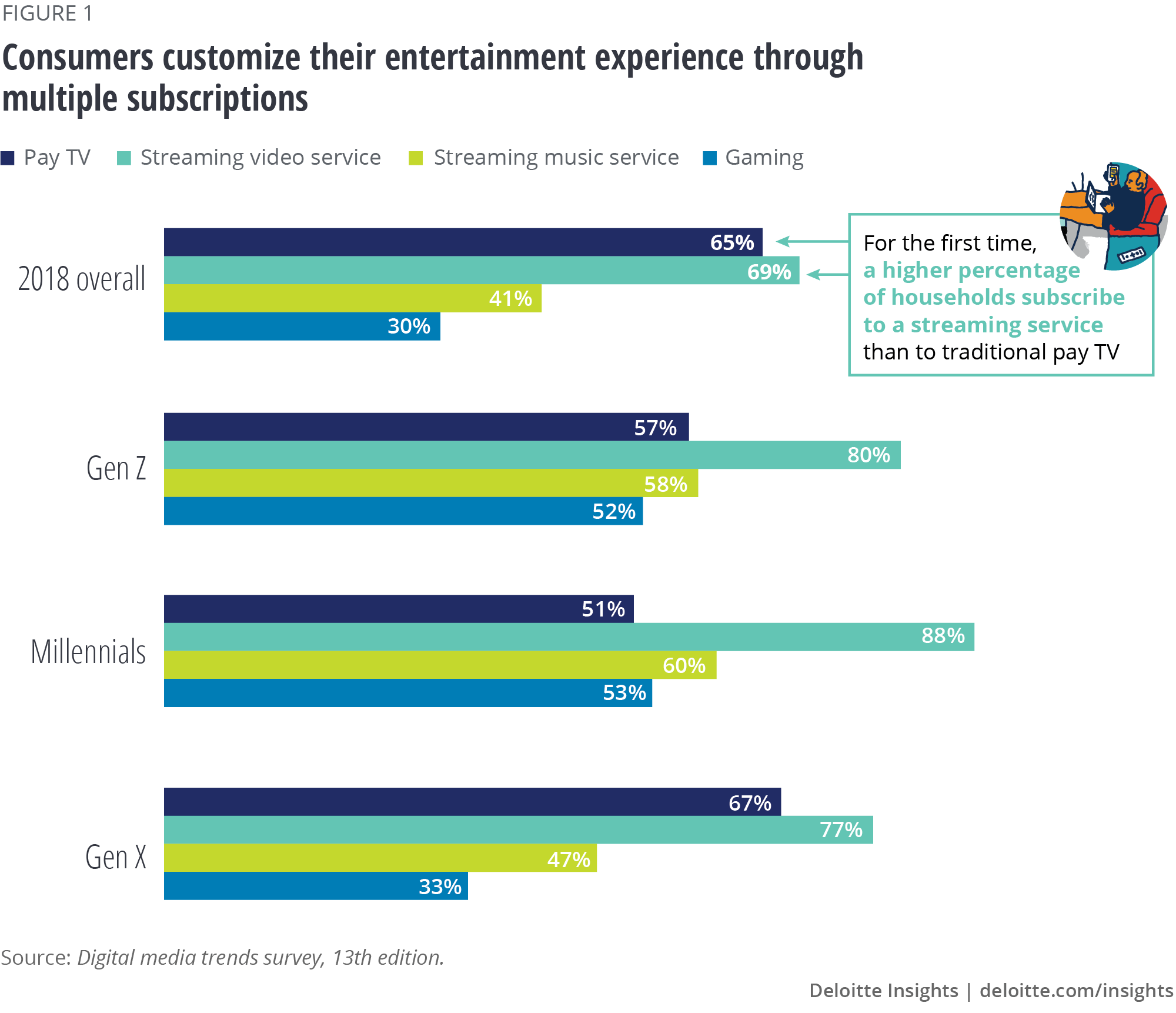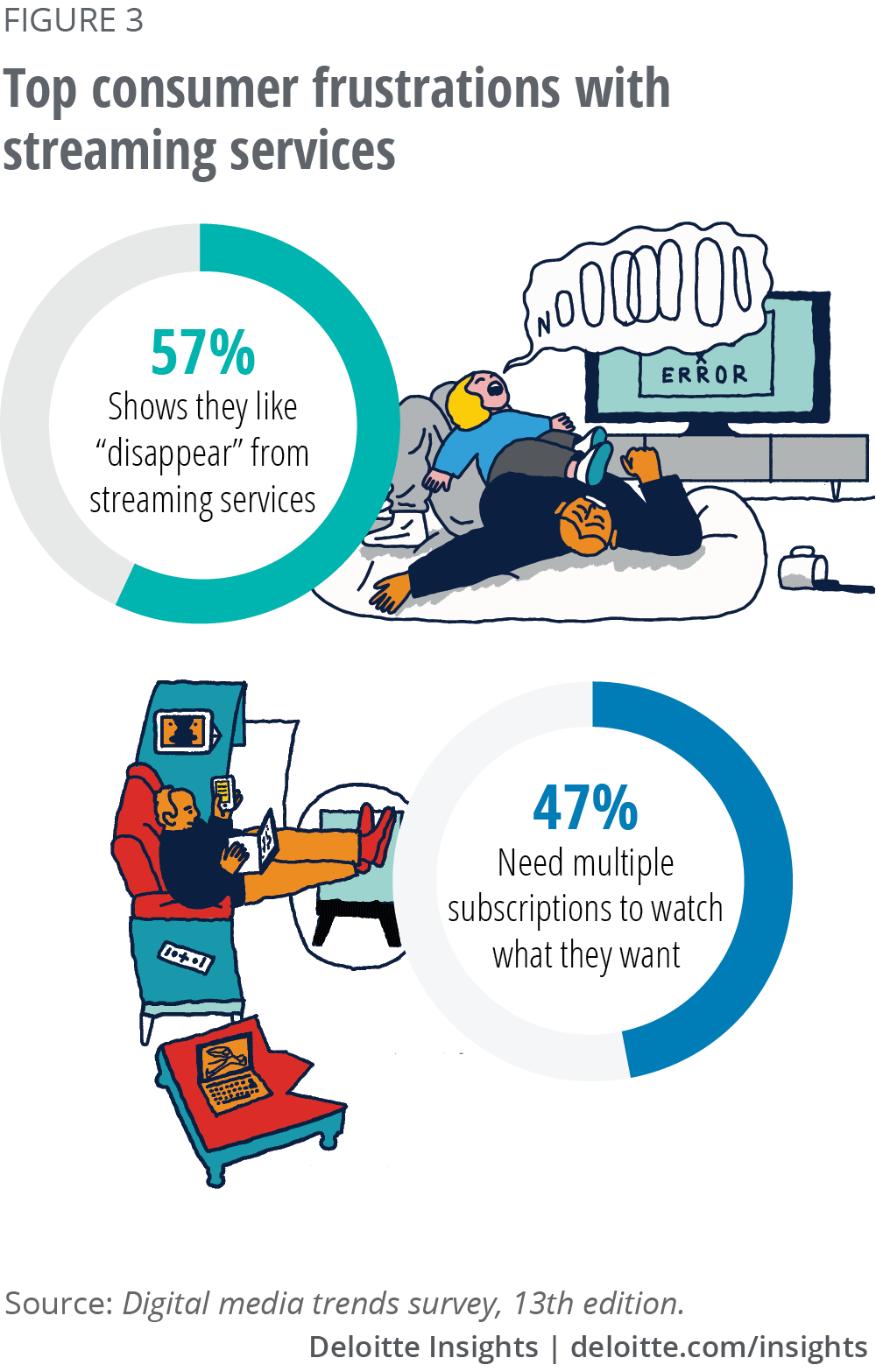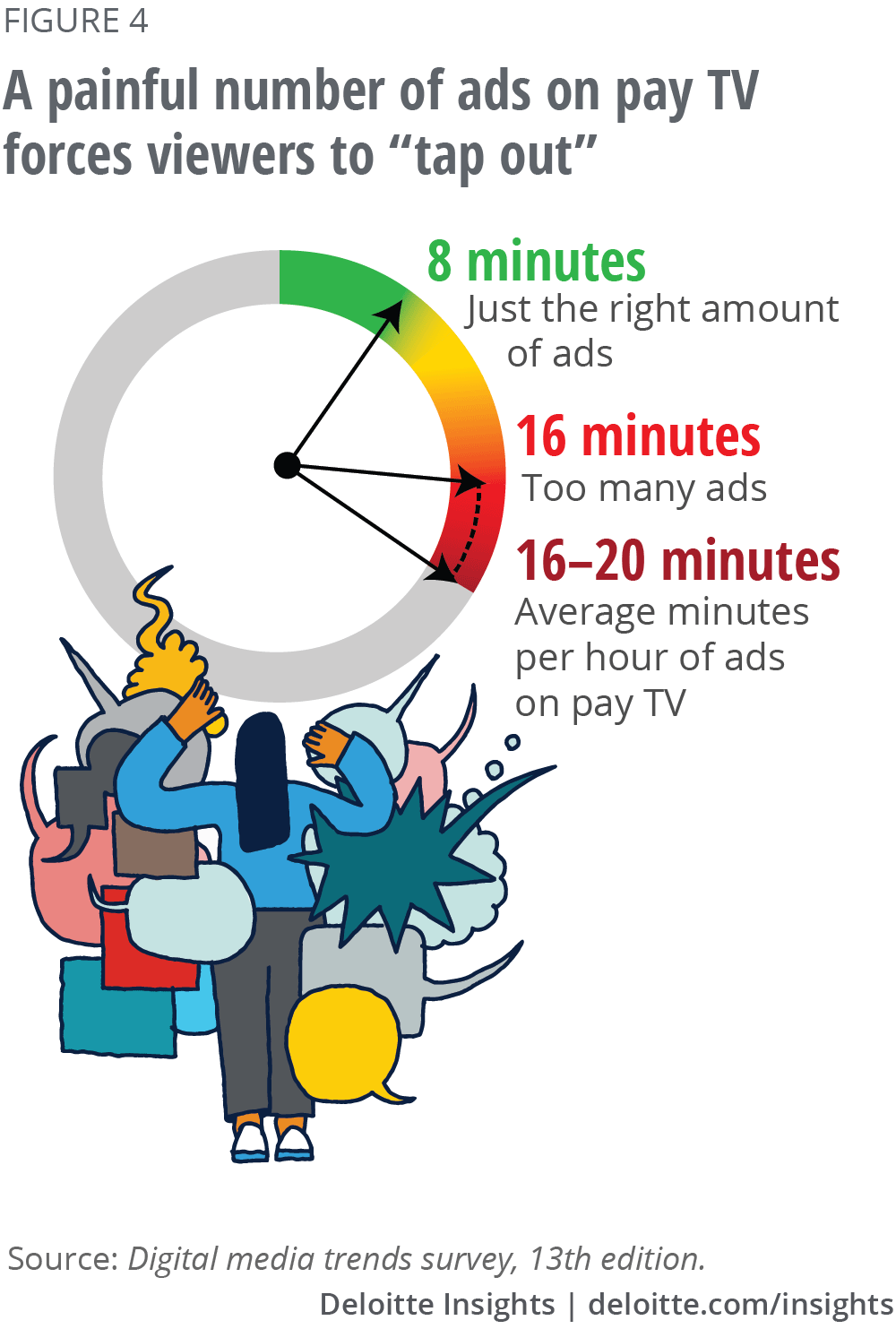
Digital media trends survey, 13th edition Piecing it together
9 minute read
19 March 2019
 Kevin Westcott United States
Kevin Westcott United States Jeff Loucks United States
Jeff Loucks United States Kevin Downs United States
Kevin Downs United States Jeanette Watson United States
Jeanette Watson United States
Consumers have more digital media options than ever, and most are finding what they want. But many are becoming frustrated by the complexity and effort piecing together their entertainment experience requires.
American consumers are “piecing together” their own media and entertainment experience from a growing variety of options, according to this year’s Digital media trends survey. While last year’s survey showed consumers had started to take control over their own entertainment experience, now they are moving further in this direction, selecting which services among pay TV, streaming video, music, and gaming options they find most valuable. But they often need to cobble together multiple services—from paid to free, ad-supported options—to watch all of their favorite programs. Still, few would trade their newfound freedom for the limited options of the past.
About Digital media trends
The 13th edition of Digital media trends survey, conducted by Deloitte’s Technology, Media & Telecommunications practice, was fielded by an independent research firm from December 2018 to February 2019. It employed an online methodology among 2,003 US consumers. All data is weighted back to the most recent census to give a representative view of what US consumers are doing. For meaningful changes, we look for differences in year-over-year tracking and generations of at least five percentage points. The figure below shows a breakdown of how we define the five generations represented in this survey.

Consumers are piecing together their media experience
Streaming services have quickly become one of Americans’ preferred ways to consume video programming. For the first time in our survey, more respondents have at least one streaming video subscription (69 percent) than have a traditional pay TV subscription (65 percent).1
But “streaming services versus traditional pay TV” is not an either/or proposition for many: Consumers often want both. Forty-three percent of US households now subscribe to both pay TV and streaming video services. For live TV news, sports, and TV shows, most consumers still turn to traditional pay TV networks, although live TV streaming services are gaining traction.
In addition to watching a lot of video, consumers also find time to listen to music and play video games. Penetration of music streaming services rose to 41 percent, a 58 percent increase from last year. Younger consumers, in particular, put music in the “must-have” category: Close to 60 percent of Gen Z and millennial consumers subscribe to a music streaming service (see figure 1).

Some streaming video and wireless service providers are bundling music with their own subscriptions. These bundles, which offer reduced2 or free3 music streaming, are helping to bolster the number of streaming music subscribers. They are also effectively placing music services at the center of content reaggregation by allowing customers to combine subscriptions.
As games become both more immersive and portable, consumers across generations are adding gaming to the mix. Thirty percent of consumers surveyed subscribe to a gaming service, and 41 percent play video games daily or weekly. As expected, adoption rates are even higher for Gen Z and millennial respondents: More than one-half say they subscribe to a gaming service and play daily or weekly.
Gaming is competing with other forms of entertainment not only in time spent but also in the way gaming platforms engage fans.4 Consumers don’t just like playing video games; they like to watch the best play against one another. The survey found that 32 percent of respondents watch eSports on a weekly basis. Gaming platforms attract millions of daily viewers, thanks to the close interaction between eSports pros and their fans, both of whom often stream their own game play live.
Video streaming services are central to consumers’ viewing experience
With more than 300 streaming video services to choose from,5 consumers are trying and buying a variety of subscription-based or ad-supported video streaming services. Given the intense competition for viewers, consumers can usually find what they want to watch for what they’re willing to pay—if they’re willing to manage multiple subscriptions.
And they are willing. Consumers subscribe to an average of three paid streaming video services. But how do they decide among literally hundreds of options?
One of the primary reasons consumers choose a particular streaming video service is access: to watch shows and movies they can’t get anywhere else. In 2018, 57 percent of paid streaming video users said they subscribed to access original content. This number is even higher among millennials, at 71 percent.
Streaming services understand this, and that’s one reason they’re spending billions to produce award-winning entertainment. In 2018, Netflix tied cable network Home Box Office (HBO) for the most Emmy Awards (23) after topping the list for the number of Emmy nominations (112)—a first for a streaming service.6 Streaming services also surpassed broadcast networks for the number of scripted TV programs last year.7
Some consumers are willing to pay a subscription fee to have an ad-free experience: 44 percent of respondents cited “no ads” as a top reason for subscribing to a new paid streaming video service. Others are willing to view ads in exchange for content. Among millennials who stream video, nearly one-half (46 percent) of the time they stream from paid services, and nearly one-third (29 percent) of the time they stream from free, ad-supported video sites like YouTube or Sony Crackle (figure 2). The remainder of their time is split almost equally among streaming from pay TV services, live TV streaming services, and rental/video on demand.

While exclusive content is a major draw for streamers, so is live TV, especially for those without a pay TV subscription. Some pay TV subscribers add live streaming to access programming that’s not available through their service. Our survey found that 29 percent of consumers pay for a live TV streaming service, and up to 41 percent of consumers have access to a live TV streaming service.
Consumers find their voice ... assistant
Voice-enabled digital assistants, such as Google Assistant and Amazon Alexa, could soon change how people engage with media content of all kinds. But not quite yet.
Ownership of voice-enabled home digital assistants, or smart speakers, grew 140 percent this year, from 15 percent in 2017 to 36 percent in 2018. The rapid rise of smart speaker ownership is due in part to their low price,8 and to the intuitive way they help people play their favorite music. This connection to music could be why consumers who use digital assistants say they interact with digital assistants more on home devices (42 percent of the time) than they do on smartphones (34 percent of the time).
Outside of playing music, digital assistants have not yet found their killer app. Just 18 percent of consumers say they engage with a digital assistant daily. This could change fast, especially if they become instrumental in helping consumers find video content.
Early adopters are already using virtual assistants to control their TVs and search streaming services for content.9 This is getting easier as devices like smart TVs are integrated with digital assistants10 and streaming services can be controlled by them.11
Rapid advances in artificial intelligence (AI) are improving virtual assistants’ ability to understand what consumers say and want.12 And a new generation of smartphones is being equipped with dedicated AI chips.13 Finally, the big technology companies are competing hard to be the “voice of the consumer” by making their digital assistant the main way people do everything: play a song, find a movie, buy groceries, and turn down the heat in their homes. While digital assistants are not quite there yet, they may be very soon.
With freedom comes friction
While consumers appreciate the freedom to customize their entertainment experiences, they don’t enjoy the friction—the hassles, responsibilities, and even vulnerabilities—that can result from choosing options à la carte. Below are the leading causes of frustration among consumers:
When shows disappear. Few things frustrate consumers more than when shows disappear from libraries on streaming services (see figure 3). This is happening more frequently as more studios and TV networks are pulling content from the major streaming services to launch their own direct-to-consumer offerings.14 While consumers may sign up for a streaming service for its original content, having a broad library of shows and movies matters, too. As this library is thinned, the service loses some of its value, and consumers are either forced to add other services or to live without some of their favorites.

Discovery difficulties. Many opt for multiple services instead of “going without.” But nearly one-half (47 percent) are frustrated by the growing number of subscriptions and services they need to piece together to watch what they want. Forty-eight percent say it’s harder to find the content they want to watch when it is spread across multiple services. And even a major benefit of having multiple subscriptions—lots of great shows and movies—can be frustrating because consumers have difficulty discovering them. Forty-three percent of consumers report that they give up on the search for content, if they can’t find it in a few minutes. Despite having so many options, many consumers still feel that “a good show is hard to find.”
Data concerns. As consumers subscribe to more services, they must dole out financial and personal information. And they are tracked as they view ads. The more “pieces” they use to customize their experience, the more vulnerable they may be to security breaches and loss of privacy. Consumers fear identity theft, financial loss, and the use of sensitive data without their authorization because many have experienced it: Twenty-three percent of US households were victimized by cybercrime in 2018.15 As a result, consumers want to control their data the way they’re controlling their entertainment experience. Forty-nine percent of consumers believe they are responsible for protecting their data and 88 percent believe they should own it. Very few respondents—just 7 percent—believe that the government is responsible for protecting their data.
Too much advertising. Consumers understand that ads are part of the entertainment experience, and most are willing to sit through some ads, especially if they’re getting free content as a trade-off. But too many ads can be painful for customers.
For example, 75 percent of consumers say there are too many advertisements on pay TV. Consumers feel that 8 minutes of ads per hour is the right amount, and say they quit watching after 16 minutes. Yet, pay TV typically features between 16 and 20 minutes of ads per hour.16 (See figure 4.) This amount is truly unacceptable to some consumers; they opt out.

In addition, 77 percent report that ads on pay TV should be shorter—less than 10 seconds—and 82 percent say there is too much repetition in the ads they view.
Conclusion: Winners should increase flexibility and reduce the friction of choosing
Consumers have never had so many choices about how they spend their entertainment time and money, and they enjoy having the flexibility to select from hundreds of services. Internet-based video and music streaming and gaming platforms are relatively new pieces that consumers can select and arrange depending on their interests and budget. A few have quickly become new cornerstones of the media experience; it’s hard to imagine life without them. Traditional pay TV has been eclipsed by streaming video in overall subscribers, but it remains a key piece of the puzzle for 65 percent of consumers surveyed.
Digital assistants are already making it easy—and fun—for consumers to manage their entertainment experience by simply asking. Advances in AI, including better voice recognition, more processing power on devices, and a growing device ecosystem, could reduce much of the friction consumers complain about. It could also put the tech companies that created digital assistants in the driver’s seat.
Respondents said they are quickly learning that with freedom comes responsibility, however, which has a downside. Consumers are tiring of the friction of managing multiple subscriptions and the hassles that come with it. This friction will likely rise as more networks and studios go direct with their own streaming services, pulling content from rivals and fragmenting the market. Costs for content may go up, and if they do, consumers and services lacking critical mass may put pressure on the industry to reaggregate.
Overall, consumers say they are getting much of what they want but are frustrated by the complexity and effort to get it. They want the ability to customize their media experience with à la carte options while reducing the friction of too many subscriptions to pay for and manage, too many ads, and the looming threat of their data being compromised or misused.
In this puzzle of a marketplace, who will win? We believe companies that are best able to reduce the friction, making it easier for consumers to have it their way, will be most amply rewarded.
These insights represent just a portion of the data included in the complete Digital media trends survey, 13th edition. If you are interested in additional insights, please email us at tmttrends@deloitte.com.
© 2021. See Terms of Use for more information.
Explore more in Telecom, Media & Entertainment
-
The eSports industry hits the big leagues Article6 years ago
-
How to begin regulating a digital reality world Article6 years ago
-
How experienced TMT organizations are navigating AI Article6 years ago
-
Intelligent interfaces Article6 years ago
-
Connectivity of tomorrow Article6 years ago










